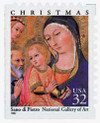
# 3176 - 1997 32c Traditional Christmas: Madonna and Child
US #3176
1997 Madonna & Child (single) – Traditional Christmas Series
- Pictures Sano di Pietro’s 15th-century Madonna and Child with Saints and Angels painting
- Part of the Traditional Christmas Series
- First Traditional Christmas stamp issued only in a self-adhesive pane of 20 (USPS calls it a convertible booklet)
- First Traditional Christmas stamp printed offset only
Stamp Category: Commemorative
Series: Traditional Christmas
Value: 32¢, First Class Mail Rate
First Day of Issue: October 27, 1997
First Day City: Washington, DC
Quantity Issued: 882,500,000
Printed by: Bureau of Engraving and Printing
Printing Method: Offset, Microprinting
Format: Panes of 21 (20 stamps and 1 non-stamp label)
Perforations: 10 (Die-cut simulated perforations – non-stamp label has die-cuts in tic-tac-toe pattern on its face)
Tagging: Phosphored paper
Why the stamp was issued: To showcase Sano di Pietro’s 15th-century painting Madonna and Child with Saints and Angels, which hangs in the National Gallery of Art in Washington, DC.
About the stamp design: Pictures a cropped section of di Pietro’s painting with the artist’s name and name of the museum where the painting is displayed in black type beneath the bottom frameline of the vignette.
Special design details: Includes microprinted inscription “CHRISTMAS 1997” in black, on the side of Mary’s hood to the right of her face.
First Day City: The First Day of Issue ceremony was held on the West Main Floor in Gallery 8 of the National Gallery of Art in Washington, DC. The original painting is on display there.
About the Traditional Christmas series: In 1966, the Post Office came up with a plan to produce Christmas stamps utilizing classic paintings of the Madonna and Child. These stamps wouldn’t violate the separation of church and state because they were a celebration of culture. On November 1, 1966, the first US Madonna and Child stamp was issued. It pictured the 15th century painting Madonna and Child with Angels by Flemish artist Hans Memling.
The stamp was very popular and over 1.1 billion were printed. The same design was used the following year, but on a larger stamp with more of the painting showing. The popularity of the stamp continued, leading the Post Office to issue another Traditional Christmas stamp in 1968, this time picturing the Angel Gabriel.
In 1969, the Post Office returned to a non-religious stamp theme, with Winter Sunday in Norway, Maine. The following year, to appease all audiences, the US issued one Traditional Christmas stamp of the Nativity and a block of four picturing Christmas toys. The decision proved popular and both Traditional and Contemporary Christmas series have continued ever since.
History the stamp represents: The religious theme of the traditional Christmas stamp was continued in 1997 with a detail from Sano di Pietro’s Madonna and Child with Saints and Angelsi. The original painting, which measures 25.5 x 17.5 inches, is part of the Samuel H. Kress Collection at the National Gallery of Art in Washington, DC.
Sano di Pietro was quite important in his hometown of Siena, Italy, where his conservative, decorative style was popular. He was commissioned to paint altar-pieces, panels, and miniatures in Siena and in neighboring districts. Sano was also a very productive painter – there are more than 300 of his known works still in existence today. He completed Madonna and Child with Saints and Angels in 1471, at the age of 65.
In the painting, the Christ child is being held by his mother while he is holding a bird and looking at the saints and angels near him. The painting is characteristic of Sano di Pietro’s use of bright, ornate colors and pious themes. It is also a beautiful example of his careful craftsmanship.
Historically, Sano di Pietro’s contribution to art was the way in which he continued the typical form of the Sienese tradition, keeping alive the technique and style of the previous century.
US #3176
1997 Madonna & Child (single) – Traditional Christmas Series
- Pictures Sano di Pietro’s 15th-century Madonna and Child with Saints and Angels painting
- Part of the Traditional Christmas Series
- First Traditional Christmas stamp issued only in a self-adhesive pane of 20 (USPS calls it a convertible booklet)
- First Traditional Christmas stamp printed offset only
Stamp Category: Commemorative
Series: Traditional Christmas
Value: 32¢, First Class Mail Rate
First Day of Issue: October 27, 1997
First Day City: Washington, DC
Quantity Issued: 882,500,000
Printed by: Bureau of Engraving and Printing
Printing Method: Offset, Microprinting
Format: Panes of 21 (20 stamps and 1 non-stamp label)
Perforations: 10 (Die-cut simulated perforations – non-stamp label has die-cuts in tic-tac-toe pattern on its face)
Tagging: Phosphored paper
Why the stamp was issued: To showcase Sano di Pietro’s 15th-century painting Madonna and Child with Saints and Angels, which hangs in the National Gallery of Art in Washington, DC.
About the stamp design: Pictures a cropped section of di Pietro’s painting with the artist’s name and name of the museum where the painting is displayed in black type beneath the bottom frameline of the vignette.
Special design details: Includes microprinted inscription “CHRISTMAS 1997” in black, on the side of Mary’s hood to the right of her face.
First Day City: The First Day of Issue ceremony was held on the West Main Floor in Gallery 8 of the National Gallery of Art in Washington, DC. The original painting is on display there.
About the Traditional Christmas series: In 1966, the Post Office came up with a plan to produce Christmas stamps utilizing classic paintings of the Madonna and Child. These stamps wouldn’t violate the separation of church and state because they were a celebration of culture. On November 1, 1966, the first US Madonna and Child stamp was issued. It pictured the 15th century painting Madonna and Child with Angels by Flemish artist Hans Memling.
The stamp was very popular and over 1.1 billion were printed. The same design was used the following year, but on a larger stamp with more of the painting showing. The popularity of the stamp continued, leading the Post Office to issue another Traditional Christmas stamp in 1968, this time picturing the Angel Gabriel.
In 1969, the Post Office returned to a non-religious stamp theme, with Winter Sunday in Norway, Maine. The following year, to appease all audiences, the US issued one Traditional Christmas stamp of the Nativity and a block of four picturing Christmas toys. The decision proved popular and both Traditional and Contemporary Christmas series have continued ever since.
History the stamp represents: The religious theme of the traditional Christmas stamp was continued in 1997 with a detail from Sano di Pietro’s Madonna and Child with Saints and Angelsi. The original painting, which measures 25.5 x 17.5 inches, is part of the Samuel H. Kress Collection at the National Gallery of Art in Washington, DC.
Sano di Pietro was quite important in his hometown of Siena, Italy, where his conservative, decorative style was popular. He was commissioned to paint altar-pieces, panels, and miniatures in Siena and in neighboring districts. Sano was also a very productive painter – there are more than 300 of his known works still in existence today. He completed Madonna and Child with Saints and Angels in 1471, at the age of 65.
In the painting, the Christ child is being held by his mother while he is holding a bird and looking at the saints and angels near him. The painting is characteristic of Sano di Pietro’s use of bright, ornate colors and pious themes. It is also a beautiful example of his careful craftsmanship.
Historically, Sano di Pietro’s contribution to art was the way in which he continued the typical form of the Sienese tradition, keeping alive the technique and style of the previous century.









